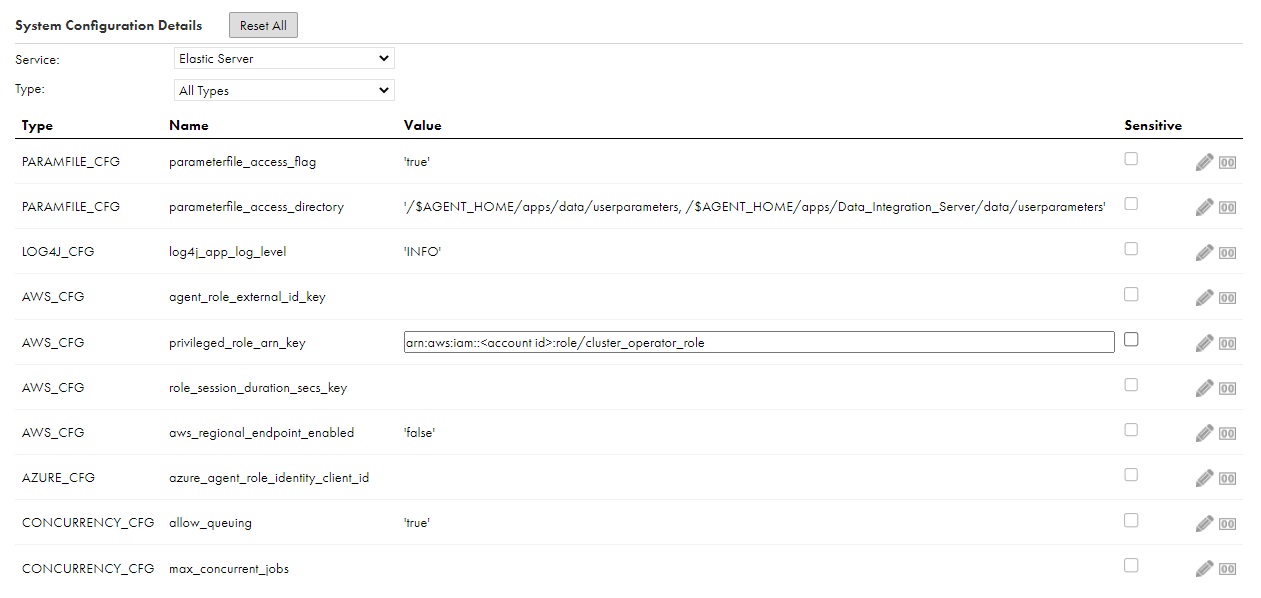Administrator
- Administrator
- All Products


Type
| Name
| Description
|
|---|---|---|
PARAMFILE_CFG
| parameterfile_access_flag
| Indicates whether developers can download parameter files that are stored on the Secure Agent machine.
Default is 'true.'
|
PARAMFILE_CFG
| parameterfile_access_directory
| List of directories on the Secure Agent machine that allow parameter file download. Developers can download parameter files from any of the specified directories or subdirectories.
Default is '/$AGENT_HOME/apps/data/userparameters, /$AGENT_HOME/apps/Data_Integration_Server/data/userparameters.'
|
LOG4J_CFG
| log4j_app_log_level
| Level of detail that the
Elastic Server writes to log files. Enter the logging level as a string, such as 'INFO.'
As the logging level increases, the messages that the
Elastic Server writes to log files include the messages in the prior logging levels. For example, if the logging level is INFO, the log contains FATAL, ERROR, WARNING, and INFO code messages.
The following values are valid:
|
AWS_CFG
| agent_role_external_id_key
| External ID that the Secure Agent specifies when the agent attempts to assume the cluster operator role. Required if you configure an external ID in the trust relationship of the cluster operator role.
This property takes effect only in an AWS environment.
|
AWS_CFG
| privileged_role_arn_key
| ARN of the cluster operator role.
Required when you set up separate cluster operator and Secure Agent roles in an AWS environment.
This property takes effect only in an AWS environment.
|
AWS_CFG
| role_session_duration_secs_key
| Session duration of the AWS AssumeRole API in seconds. By default, the session duration is 1800 seconds (30 minutes).
Overrides the maximum CLI/API session duration that is configured for the cluster operator role. If the session duration configured for the
Elastic Server is longer than session duration for the cluster operator role, the Secure Agent might fail to assume the cluster operator role.
This property takes effect only in an AWS environment.
|
AZURE_CFG
| azure_agent_role_identity_client_id
| Client ID of the managed identity
agent_identity . Required when
agent_identity is a user-assigned managed identity and the Secure Agent machine has at least one other managed identity.
This property takes effect only in an Azure environment.
|
CONCURRENCY_CFG
| allow_queuing
| Indicates whether the
Elastic Server queues Spark tasks. Default is true.
|
CONCURRENCY_CFG
| max_concurrent_jobs
| Maximum number of concurrent Spark tasks that the
Elastic Server can process.
|
Tomcat JRE | INFA_MEMORY | Minimum and maximum heap size. For the Elastic Server , the default is '-Xms256M
-Xmx2048M' , with 256MB minimum memory and 2048MB
maximum memory.For more information, see Data Integration Performance Tuning and the
following Knowledge Base article: FAQ: What are the guidelines
and best practices to increase Java heap size and other
memory attributes of the Informatica Cloud Secure
Agent?
|